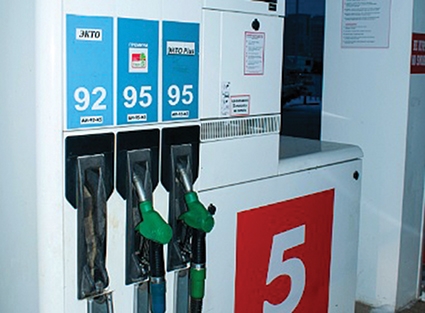Prices for Russian Gasoline Held Back, Growth Inevitable
Russian wholesale gasoline prices are growing faster than some experts expected, linking it to an unexpected reduction in fuel output at the Moscow refinery of Gazprom Neft. However, a number of analysts point out that wholesale prices for fuel were kept from sharp growth for as long as possible artificially, but now they will grow confidently.
According to St. Petersburg International Commodity Exchange, the price of one ton of AI-92 gasoline increased by 2.3% between November 7 and 13 to 42,850 Roubles, while a ton of AI-95 fuel went up by 1.7% to 44,990 Roubles. This data is confirmed by information and analytical center “KORTES”.
Gasoline has also appreciably risen in price and will continue to rise, which, in general, is not very typical for this time of year, when the cost of fuel usually declines.
According to Yevgeny Arkushi, head of the Russian Fuel Union (RFU), the temporary shutdown of the plant at the Moscow Refinery is one factor, while, strategically, the prices for gasoline depend on two main factors: inflation and increasing of tax burden. In the Russian Federation, the tax on the extraction of minerals increases by the year, a process which inevitably hits consumers.
Oil prices were also up this autumn: Brent Oil was in the price range of $60 per barrel, and the price is already higher, at the level it was two years ago.
The consensus of expert opinions is that the rise in prices for various grades of gasoline is directly linked to the policy of the state, which soon after the crisis followed a course of containing the rise in fuel prices, so after a sharp weakening of the Rouble at the end of 2014, the same increase in prices for gasoline did not happen. Now, as the country announces an improvement in the economic situation, a natural process of increasing the cost of fuel has begun. Natural, because in Russia the oligopolies are happy about it. An oligopoly is a market form wherein a market or industry is dominated by a small number of sellers. Oligopolies can result from various forms of collusion which reduce competition and lead to higher prices for consumers.
“As a result, gasoline and diesel fuel in Russia became the cheapest in Europe (in currency prices),” said Rustam Tankayev, CEO of InfoTEK-Terminal. “This is unquestionably good for the population during the crisis, but not so positive for the market. First, the flow of imported gasoline from Belarus, Finland and Southeast Asia to the Far East became unprofitable and disappeared. Secondly, the production of Russian gasoline declined: where in 2012, 95% of the oil supplied to the refinery was processed, in 2016 it was only 80%,” he said, adding that he does not believe that this situation will continue for long, as, if production of gasoline is unprofitable to the manufacturer, then, despite all political and administrative measures, it will do everything possible to reduce production.
A year earlier, losses from the production of gasoline and diesel fuel were partly offset by profit from other types of oil refining, mainly petrochemicals. “Today, the situation is different: prices will tend to achieve either at least parity with production costs, or a new gasoline crisis will occur, similar to what Russia experienced in 2007,” Tankayev pointed out.
Alexander Pasechnik, Head of the Analytical Department of the National Energy Security Fund (NESF), said that vertically integrated companies (VIC) shifted the profit center to wholesale trade, thereby restraining the growth of retail prices, but “this situation, in fact, strangles independent sellers, and because according to statistics, their gas stations are larger than the gas stations of large companies.”
Analysts predict that the increase in fuel prices is not a one-time process: it will continue, although not abruptly, because, as they say, the presidential elections are up-coming. Therefore, the government will hardly be openly angered by power, but will nevertheless try to contain the rise in gasoline prices within the framework of inflation.
“Sharp price increases until March 2018 will not be due to the approaching elections and the traditional winter fall in demand,” Tankayev predicts. “But by the middle of next spring, we’ll see 95 gasoline at retail at a price of up to 50 Roubles per liter, unless there is a growth in the Rouble / Euro rate. Dependence on the Euro is not accidental as Russia’s neighbours are guided by European prices”.
To all that, the fact that car sales began to increase again in the country also adds to the negative for ordinary Russian citizens as, usually in such cases, the cost of fuel increases in parrallel.
Dimitri Dolaberidze











